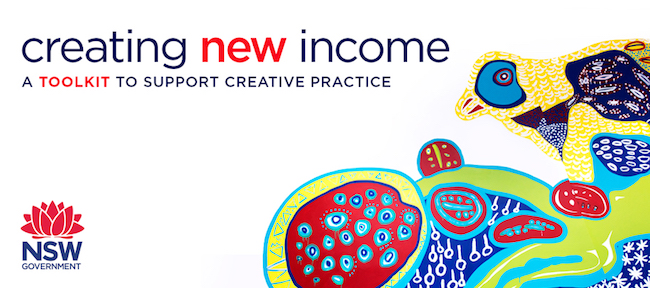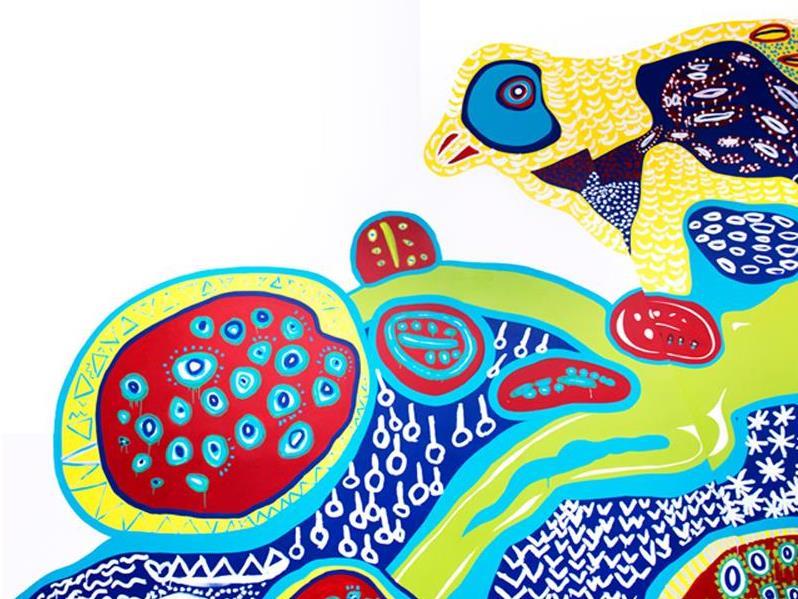Lorikeet Bushy Tree Mandala (detail) Emily Crockford, Studio A. Mural in Westpac Service Centre, Concord West, NSW. Photo: Jessica Leggett.
How to successfully generate income as a small to medium arts organisation or creative practitioner is perhaps the most pressing question of our times.
Create NSW’s Creating New Income: A toolkit to support creative practice has come as a well-timed blessing with its clear, practical advice that is easily accessed online or as a downloadable resource.
Ann Hinchliffe, Senior Policy Lead who worked with industry experts to develop the Toolkit, told ArtsHub: ‘The objective of the Toolkit is to awaken people’s understanding of where other sources of income can come from.’
‘Having worked in several arts organisations, I really appreciate how precious– and pressured – time is. What we wanted to do was to provide a road map to start exploring funding alternatives.’
The Toolkit is a comprehensive set of 50 guides and case studies that have been developed to build strategies to generate alternative income streams, increase sustainability and leverage new commercial and philanthropic opportunities.
Hinchliffe continued, ‘This it isn’t a total mystery; there are some very straightforward procedures that you can embrace, like how to engage your donors in 12 easy steps.’
She said she knows the feeling of that looming pressure to raise money. ‘It can be overwhelming. Where do I start, where do I focus my effort, and how do I leverage my network? Our Toolkit is about demystifying those concerns.’
The guides provide clear “how-to” instructions on growing and developing new incomes ‘streams under the topics:
- Being Fit for Fundraising
- Building your donor base
- Telling your story
- Trusts and Foundations
- Major Gifts
- Crowdfunding and Collective Giving
- Business Sponsorship
- New Products and Services
The resource was an outcome of the Arts 2025 Summit held in March 2018 and was launched by Minster for the Arts Don Harwin at Artstate Bathurst in November. It has since been one of the most visited offerings on Create NSW website.
This demand for ‘know- how’ in the funding area has been so great that Create NSW’s information session on the Toolkit, to be presented at Sydney Opera House in late January, sold out within two days.
The Agency will be addressing that demand, rolling out further information sessions over the year ahead. Bookmark their website for continuing news on programs.

Cutting through the funding quagmire
Create NSW engaged industry experts to develop the Toolkit. Hinchliffe said that in the research phase of the project, the most common question from the sector was “Where do I start when I have no time and no resources?”
The Toolkit has been designed so one can “dip in”. Create NSW suggests that you don’t need to read all of it at once. They suggest you start with the first three topics: Being Fit for Fundraising, Building donor base, and Telling your story.
Hinchliffe’s advice was to start with the community you have.
‘They are really engaged with your work. Know that pool of people! When you combine your Instagram followers, your Facebook followers and your mailing list that is a huge net of engaged people. And think about your providers – the people who you buy things from – and start the conversation about pro-bono partnerships,’ she said.
‘In fact, you have a much broader bunch of supporters and network than most people realise. Engage them. Get them to help you tell your story.’
It was advice shared by Arts Law CEO Robyn Ayres: ‘It’s important to value these relationships and be actively engaged with your partners so you understand their needs and what they want to get out of supporting you. There’s quite a lot of work that goes into being a good partner and ensuring you remain a charity they want to work with.’
65 per cent of the Arts Law Centre of Australia’s income is funded through government grants, down from 80 per cent a few years ago. With 13 staff and 240 legal practitioners providing $1.5 million in pro bono services, alternative streams of income have become essential.
Ayres told ArtsHub: ‘Whilst Government support remains crucial for arts organisations, given an environment of less reliable Government support, Arts Law has worked hard to develop other income streams to support our sustainability into the future. We have done this in a variety of ways including fee for service work as well as a greater focus on fund-raising activities and philanthropic support.’
Four Winds at Bermagui on NSW’s South Coast has long been touted a success story and is another case study offering real advice in the Toolkit.
Executive Director David Francis said: ‘Four Winds is always experimenting with ways of generating revenue. We held an outdoor film festival that was very popular. We’ve tried using our venues for weddings and conferences, which was less successful. We’re now arriving at a clearly-defined model as a social enterprise, with a pragmatic view of what works and what doesn’t.’
Francis added that they have found it more challenging to fund cause-based projects such as their education program, for example, rather than attracting donor support for something tangible like purchasing a grand piano.
‘We’re working hard to ensure our donors know they are funding projects with a core objective so that they feel connected to the results,’ said Francis.
Studio A is a Sydney-based organisation that supports 15 artists and employs nine full-and part-time staff; they have no fundraising specialist on staff, but have achieved results.
CEO Gabrielle Mordy told ArtsHub: ‘For an artist or arts company to operate, sustainably generating income is as important as making great art – in fact it can be the pathway to making great art. But like me, many arts practitioners lack formal training in business.’
‘[The] Create NSW toolkit is a rare resource helping to fill this knowledge gap, the toolkit speaks in plain English to outline practical and tested ways of generating essential revenue from diverse channels.’
Mordy explained how a rebrand in 2015 bolstered their fundraising efforts. ‘We embarked on a rebrand that would counter perceptions about disability and the arts. The strength of our brand certainly helps in our fundraising efforts. Recently I met a major arts organisation and was told we got the agreement over the line because they love the way we present ourselves.’
She added: ‘I consistently get this kind of feedback – particularly from newly introduced people saying how much they love our brand and website.’
Mordy continued: ‘Having board members who will approach their own networks and are willing to advocate for us has been critical. If you have a board member who isn’t willing to do this, understand why not and how you can help them.’
‘The case studies are drawn from real NSW success stories,” said Hinchliffe. “They are a source of inspiration and encouragement, and all the organisations selected have very small numbers of staff, so they show that this really can be done.’
‘Create NSW is determined to do what it can to support the sector to be sustainable,” she added. “It’s a living document and it is absolutely about being easy to use.’
Download the Toolkit today so it is a quick-grab reference resource to call on.





